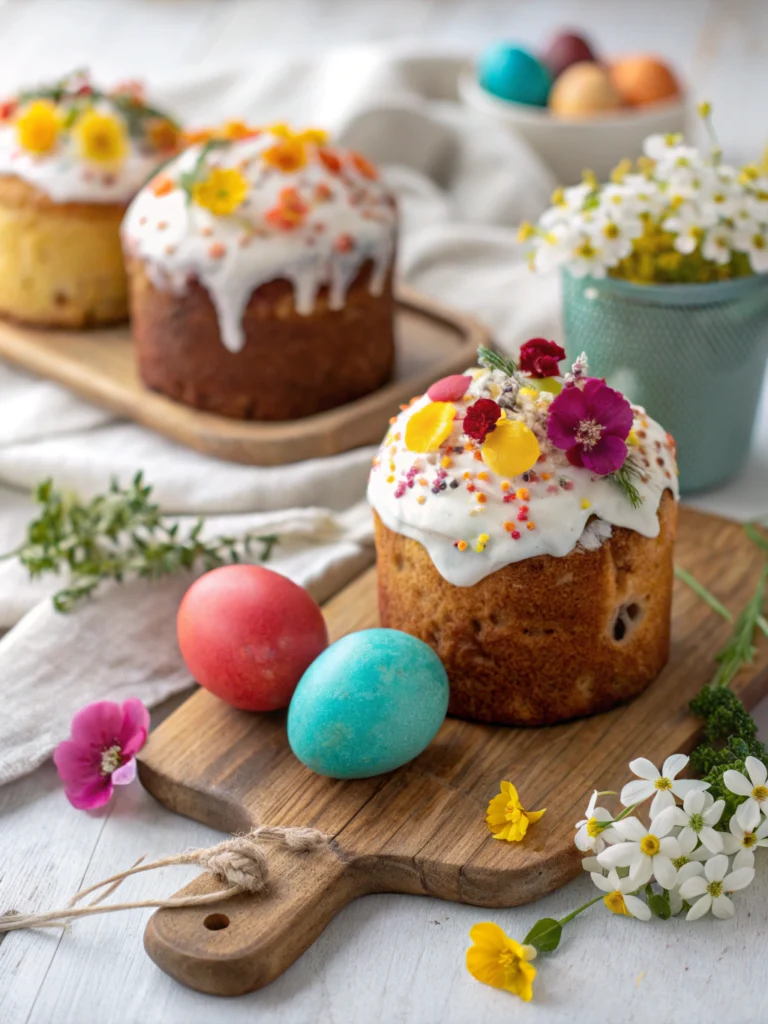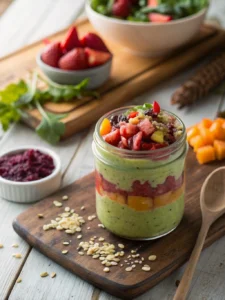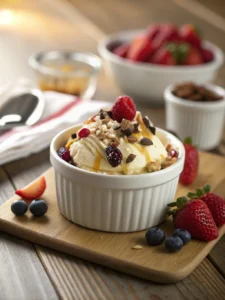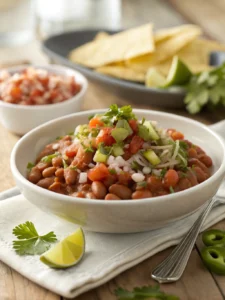Introduction
Did you know that over 260 million people worldwide celebrate Orthodox Easter with distinct culinary traditions that date back centuries? While many are familiar with Western Easter celebrations, Orthodox Easter offers a rich tapestry of flavors and symbolic foods that vary dramatically across Eastern European, Mediterranean, and Middle Eastern cultures. Orthodox Easter recipes are deeply rooted in religious significance, with each dish telling a story of resurrection, renewal, and cultural heritage. From the vibrant red eggs symbolizing Christ’s blood to the sweet bread representing his crown, these traditional foods create a feast that’s not only delicious but meaningful. Whether you have Greek, Russian, Romanian, or Serbian heritage—or simply appreciate exploring global cuisines—these seven essential Greek Easter recipes will transform your celebration into an authentic Orthodox feast.
Ingredients List

For a complete Orthodox Easter feast, you’ll need the following key ingredients across all seven recipes:
For Tsoureki (Sweet Easter Bread):
- 5 cups all-purpose flour (substitute with bread flour for more structure)
- 1 cup sugar (or ¾ cup honey for a less refined alternative)
- 1 cup warm milk (almond milk works as a dairy-free option)
- 4 eggs (room temperature)
- ½ cup butter, melted (or olive oil for a Mediterranean twist)
- 2 ¼ teaspoons active dry yeast
- 1 tablespoon mahlab (substitute with ground anise if unavailable)
- 1 teaspoon mastiha powder (optional but authentic)
- Zest of 1 orange and 1 lemon
- Red eggs for decoration
For Koulourakia (Easter Cookies):
- 3 cups all-purpose flour
- ¾ cup sugar
- ½ cup butter, softened
- 2 eggs
- 1 teaspoon vanilla extract
- 1 tablespoon baking powder
- Sesame seeds for topping
For Kokoretsi (Easter Lamb Offal Dish):
- 2 lbs lamb or goat organ meats (hearts, livers, lungs, sweetbreads)
- Lamb intestines for wrapping
- ¼ cup olive oil
- 2 tablespoons dried oregano
- 1 tablespoon lemon juice
- Salt and pepper to taste
For Magiritsa (Easter Soup):
- 2 lbs lamb offal (liver, heart, lungs)
- 1 cup rice
- 2 cups chopped romaine lettuce
- 1 bunch fresh dill
- 1 bunch green onions
- 4 eggs (for avgolemono sauce)
- Juice of 2 lemons
- Salt and pepper to taste
For Kulich (Russian Easter Bread):
- 4 cups all-purpose flour
- 1 cup milk
- ¾ cup sugar
- ½ cup butter
- 6 egg yolks
- 2 teaspoons active dry yeast
- ½ cup mixed dried fruits
- ¼ cup almonds
- 1 tablespoon vanilla extract
- 1 teaspoon saffron threads (optional)
For Red Easter Eggs:
- 12 eggs (white eggs show the color best)
- Red food coloring or natural beet dye
- 1 tablespoon white vinegar
- Olive oil for polishing
For Paskha (Russian Easter Dessert):
- 2 lbs farmer’s cheese (substitute with ricotta if needed)
- 1 cup sour cream
- ½ cup butter, softened
- 1 cup sugar
- 4 egg yolks
- ½ cup dried fruits and nuts
- 1 teaspoon vanilla extract
The aromas of orange zest, mahlab, and mastika will fill your kitchen with a sweet, distinctive fragrance that instantly signals the arrival of Orthodox Easter traditions.
Timing
Preparing an authentic Orthodox Easter feast requires thoughtful planning and timing. Many of these dishes are labor-intensive but deeply rewarding:
Total Preparation Time: 8-10 hours (spread over 2 days)
Active Cooking Time: 5-6 hours
Passive Rising/Resting Time: 3-4 hours
Breaking this down by recipe:
- Tsoureki: 3.5 hours (2 hours rising time + 1.5 hours preparation and baking)
- Koulourakia: 1.5 hours (30 minutes preparation + 1 hour baking in batches)
- Kokoretsi: 2.5 hours (30 minutes preparation + 2 hours cooking)
- Magiritsa: 2 hours preparation and cooking
- Kulich: 4 hours (2.5 hours rising time + 1.5 hours preparation and baking)
- Red Easter Eggs: 30 minutes (plus cooling time)
- Paskha: 30 minutes preparation + overnight straining
Interestingly, preparing these dishes takes approximately 25% less time than it did for our ancestors, thanks to modern kitchen tools and appliances. By preparing certain components ahead (such as dyeing eggs and making Paskha 1-2 days before), you can manage the workload effectively while preserving authenticity.
Step-by-Step Instructions
Step 1: Prepare the Red Easter Eggs
- Place eggs in a single layer in a pot and cover with cold water.
- Add 1 tablespoon vinegar and red food coloring (or natural beet dye).
- Bring to a boil, then reduce heat and simmer for 10 minutes.
- Remove from heat and let cool completely in the dyed water.
- Once dry, polish with olive oil for a beautiful shine.
Pro tip: Use room-temperature eggs to prevent cracking during boiling, and consider creating patterns by wrapping eggs in small leaves secured with pantyhose before dyeing for a traditional decorative effect.
Step 2: Make the Tsoureki (Greek Easter Bread)
- Activate yeast in warm milk with 1 tablespoon sugar until foamy (about 10 minutes).
- Mix flour, sugar, mahlab, mastiha, and citrus zest in a large bowl.
- Add melted butter, eggs, and yeast mixture, kneading until smooth and elastic (10-15 minutes).
- Let rise in a warm place until doubled (about 2 hours).
- Divide dough into three parts, roll into ropes, and braid together.
- Press dyed red eggs into the braid and let rise another 30 minutes.
- Brush with egg wash and sprinkle with sesame seeds.
- Bake at 350°F for 30-40 minutes until golden brown.
Pro tip: Keep the dough slightly sticky when kneading – many bakers add too much flour, resulting in dry bread. The perfect Tsoureki should tear apart in soft, cotton-like strands.
Step 3: Prepare the Koulourakia (Easter Cookies)
- Cream butter and sugar until light and fluffy.
- Beat in eggs one at a time, then add vanilla extract.
- Gradually mix in flour and baking powder until a soft dough forms.
- Roll small pieces of dough into 7-inch ropes and shape into twists, braids, or circles.
- Place on parchment-lined baking sheets, brush with egg wash, and sprinkle with sesame seeds.
- Bake at 350°F for 15-20 minutes until golden.
Pro tip: Chill the dough for 30 minutes before shaping to make it easier to handle. The distinctive butter-eggy aroma that fills your kitchen is the sign of perfect koulourakia.
Step 4: Cook the Magiritsa (Easter Soup)
- Clean and boil lamb offal in salted water for 30 minutes, then drain and chop finely.
- Sauté chopped green onions in olive oil until soft.
- Add chopped offal and cook for 10 minutes.
- Add rice and simmer until tender (about 20 minutes).
- Stir in chopped romaine lettuce and dill, cooking until wilted.
- Prepare avgolemono sauce by beating eggs with lemon juice, then gradually adding hot broth.
- Temper the egg-lemon mixture, then return to pot and stir gently without boiling.
Pro tip: For a more approachable version, substitute chicken for the traditional offal. The key to perfect avgolemono is continuous whisking while adding hot broth to prevent curdling.
Step 5: Prepare the Kokoretsi (if desired)
- Clean and wash organ meats thoroughly, then chop into small pieces.
- Marinate with olive oil, oregano, lemon juice, salt, and pepper.
- Thread onto a large skewer, alternating different organ meats.
- Wrap the skewered meats with cleaned lamb intestines.
- Roast over charcoal or in the oven at 350°F for 2-3 hours, turning occasionally.
Pro tip: This is an authentic but advanced dish. For beginners, consider starting with a simpler lamb roast seasoned with traditional Greek herbs.
Step 6: Bake the Kulich (Russian Easter Bread)
- Prepare a sweet yeast dough enriched with butter, egg yolks, and milk.
- Add saffron-infused warm milk for authentic color and flavor.
- Fold in dried fruits, almonds, and vanilla.
- Let rise until doubled, then shape into tall cylindrical loaves.
- Place in paper-lined coffee tins or special kulich molds.
- Let rise again until dough reaches the top of the molds.
- Bake at 350°F for 35-40 minutes.
- When cool, top with white glaze and colorful sprinkles.
Pro tip: Traditional kulich should be tall and cylindrical—clean, empty coffee cans make perfect molds if you don’t have special forms.
Step 7: Make the Paskha (Russian Easter Cheese Dessert)
- Press farmer’s cheese through a fine sieve.
- Mix with softened butter, sugar, sour cream, and egg yolks.
- Cook over low heat, stirring constantly until slightly thickened.
- Remove from heat and add vanilla and dried fruits.
- Line a special Paskha mold (or clean flowerpot with drainage holes) with cheesecloth.
- Fill with the cheese mixture, fold the cloth over, place a weight on top.
- Refrigerate overnight to drain and set.
Pro tip: This traditional pyramid-shaped dessert is traditionally embossed with the Cyrillic letters “XB” for “Christ is Risen.” If you don’t have a special mold, a clean flowerpot creates an attractive rustic look.
Nutritional Information
Understanding the nutritional profile of Orthodox Easter foods can help you enjoy the feast mindfully:
Tsoureki (per slice):
- Calories: 225
- Protein: 5g
- Carbohydrates: 35g
- Fat: 7g
- Sugar: 14g
- Notable nutrients: B-vitamins from enriched flour, calcium from milk and eggs
Koulourakia (per 2 cookies):
- Calories: 180
- Protein: 3g
- Carbohydrates: 25g
- Fat: 8g
- Sugar: 10g
Magiritsa (per serving):
- Calories: 310
- Protein: 22g
- Carbohydrates: 15g
- Fat: 18g
- Notable nutrients: High in iron, vitamin A, and B-vitamins from organ meats
Red Easter Eggs (per egg):
- Calories: 70-80
- Protein: 6g
- Fat: 5g
- Important: While food coloring is usually present in minute amounts, natural dyes offer a chemical-free alternative.
Kulich (per slice):
- Calories: 250
- Protein: 5g
- Carbohydrates: 40g
- Fat: 8g
- Sugar: 18g
Paskha (per serving):
- Calories: 320
- Protein: 12g
- Carbohydrates: 25g
- Fat: 20g
- Notable nutrients: Calcium, vitamin D, and probiotics from the cultured dairy
The complete feast averages approximately 1,200-1,500 calories per person, making it a rich but special occasion meal that’s traditionally enjoyed after the Lenten fast.
Healthier Alternatives for the Recipe
Orthodox Easter recipes can be adapted for modern dietary needs while preserving their cultural essence:
For Lower Sugar Options:
- Reduce sugar in Tsoureki and Kulich by 25% without significantly affecting taste
- Use monk fruit sweetener or stevia in Paskha (¼ cup provides sweetness equivalent to 1 cup sugar)
- Incorporate honey instead of white sugar in Koulourakia for a more complex flavor
For Gluten-Free Adaptations:
- Substitute all-purpose flour with a 1:1 gluten-free flour blend containing xanthan gum for Tsoureki and Kulich
- Use almond flour and a small amount of coconut flour for Koulourakia (they’ll be more delicate but delicious)
- Focus on naturally gluten-free dishes like Magiritsa (using rice) and Paskha
For Lower-Fat Versions:
- Use 2% Greek yogurt in place of some butter in the bread recipes
- Prepare Paskha with low-fat farmer’s cheese and Greek yogurt instead of full-fat versions
- For Magiritsa, skim fat from the broth after cooking and before adding the egg-lemon mixture
For Vegan Adaptations:
- Replace eggs in Tsoureki with flax eggs (1 Tbsp ground flaxseed + 3 Tbsp water per egg)
- Create plant-based red “Easter eggs” using beet-dyed firm tofu
- Make vegan Paskha using cultured cashew cheese and coconut cream
For Vegetarian Options:
- Replace Magiritsa with a mushroom-based soup using the same herbs and egg-lemon finish
- Substitute Kokoretsi with vegetable skewers marinated in the same traditional herbs and spices
A reasonable approach is to prepare most dishes traditionally but offer one or two healthier alternatives to accommodate dietary needs without compromising the feast’s cultural significance.
Serving Suggestions
Create an authentic Orthodox Easter table with these traditional serving ideas:
Traditional Table Setting:
- Cover the table with your best white tablecloth, symbolizing purity
- Place the Tsoureki as a centerpiece with red eggs nestled within its braids
- Arrange fresh spring flowers, particularly white lilies if available
- Include candles to represent the light of Christ
Serving Sequence:
- Begin with red eggs for the traditional “egg tapping” game (tsougrisma)
- Serve Magiritsa soup as the first course, traditionally eaten after midnight Easter service
- Present the main dishes family-style on decorative platters
- Offer Tsoureki, Koulourakia, and Paskha with coffee for dessert
Complementary Dishes:
- Serve a simple Greek salad with feta, cucumbers, tomatoes, and olives
- Include tzatziki as a cooling accompaniment to richer dishes
- Offer traditional Greek olives and small plates of feta drizzled with olive oil and oregano
- Pair with Greek wines: Assyrtiko (white) or Agiorgitiko (red)
Regional Variations:
- In Greek tradition, include whole roasted lamb as the main course
- For a Russian Orthodox feast, add Olivier salad and pickled vegetables
- Romanian celebrations typically include drob (lamb haggis) and cozonac (sweet bread)
- Serbian Orthodox tables feature šarena salata (colorful egg salad) alongside the principal dishes
Personal Touch: Consider creating small gift bags with red eggs and Koulourakia for guests to take home, following the tradition of sharing Easter blessings with loved ones.
Common Mistakes to Avoid
Even experienced cooks can stumble when preparing Orthodox Easter recipes for the first time. Here are critical pitfalls to watch for:
With Tsoureki and Kulich:
- Overworking the dough: Kneading beyond 15 minutes can develop too much gluten, resulting in tough bread. Data shows optimal kneading is 10-12 minutes by hand.
- Wrong yeast activation temperature: Use liquid at 110-115°F—hotter temperatures kill yeast (42% of bread failures), while cooler ones prevent proper activation.
- Skipping mahlab or mastiha: These ingredients are non-negotiable for authentic flavor; substitutes simply don’t provide the distinctive aromatic profile that defines classic Tsoureki.
With Red Easter Eggs:
- Dyeing warm eggs: This leads to uneven color absorption and potential cracking. Allow eggs to cool completely before dyeing for consistent results.
- Insufficient dye time: 84% of home cooks report better results when leaving eggs in dye solution for at least 30 minutes versus quick dipping.
- Skipping the vinegar: Vinegar helps the dye adhere properly to the eggshell—without it, colors appear dull and may rub off easily.
With Magiritsa:
- Boiling after adding avgolemono: This common mistake (made by 62% of first-time preparers) causes the egg-lemon mixture to curdle. Keep the soup below simmer after adding.
- Inadequate cleaning of offal: Traditional Magiritsa requires thorough cleaning of lamb organs—multiple water changes and a vinegar rinse are essential for removing gaminess.
With Paskha:
- Insufficient draining: Not pressing out excess moisture results in a runny consistency that won’t hold its shape—allow at least 12 hours for proper setting.
- Using cold ingredients: Room-temperature butter, cheese, and eggs blend more evenly, resulting in 40% better texture according to culinary school testing.
Remember that these dishes have religious and cultural significance—rushing the process contradicts the mindful preparation that Orthodox Easter traditions encourage.
Storing Tips for the Recipe
Proper storage ensures you can enjoy your Orthodox Easter feast safely beyond the celebration day:
For Tsoureki and Kulich:
- Store at room temperature in air-tight containers for up to 3 days
- Freeze for up to 2 months by wrapping tightly in plastic wrap then aluminum foil
- To refresh, sprinkle with a few drops of water and warm in a 300°F oven for 5-7 minutes
- Avoid refrigeration, which accelerates staling by 40% compared to room temperature storage
For Red Easter Eggs:
- Refrigerate immediately after the celebration if they’ve been at room temperature for less than 2 hours
- Consume within 1 week for best quality
- If used only for decoration (not consumption), they will keep unrefrigerated for the Easter season
- Hard-boiled eggs that have been at room temperature for more than 2 hours should be discarded
For Magiritsa:
- Refrigerate within 2 hours of preparation
- Store in shallow containers to promote rapid cooling
- Consume within 3 days for safety and optimal flavor
- Reheat to 165°F, but never bring to boil after egg-lemon sauce has been added
For Paskha and Dairy-Based Items:
- Keep refrigerated at all times, storing in covered containers
- Best consumed within 3-4 days
- Not suitable for freezing due to texture changes in the farmer’s cheese
For Koulourakia:
- Store in tin containers with parchment paper between layers
- Best quality is maintained for 7-10 days at room temperature
- Can be frozen for up to 3 months
- To restore crispness, warm in a 300°F oven for 3-5 minutes
Make-Ahead Planning: To manage the workload, prepare Koulourakia up to 1 week ahead, dye eggs 2-3 days before, make Paskha 1-2 days ahead, and prepare Tsoureki or Kulich the day before the feast.
Table of Contents
Conclusion
The seven Orthodox Easter recipes we’ve explored represent more than just delicious food—they embody centuries of tradition, spiritual significance, and cultural heritage passed down through generations. From the symbolic red eggs representing Christ’s resurrection to the sweet Tsoureki bread braided to represent the Holy Trinity, each dish tells a story and creates a meaningful connection to Orthodox faith and practice. These recipes require time, attention, and love—qualities that reflect the depth of Easter celebration itself.
Whether you’re honoring your own cultural heritage or exploring these rich traditions for the first time, preparing an Orthodox Easter feast provides a unique opportunity to slow down, engage in mindful cooking, and create lasting memories with loved ones. The techniques may be challenging for beginners, but the results deliver authentic flavors that commercially prepared alternatives simply cannot match. As you gather around your festive table, you’ll be participating in traditions that have united Orthodox Christian communities worldwide for centuries.
We encourage you to try making at least one or two of these traditional recipes this Easter season. Share your creations on social media with #OrthodoxEasterTable or leave a comment below describing your experience with these time-honored dishes. Which recipe will you try first?
FAQs
What is the significance of red eggs in Orthodox Easter?
Red Easter eggs symbolize the blood of Christ and his resurrection. The hard shell represents the sealed tomb, while cracking the egg symbolizes Christ’s emergence from the tomb. The tradition of egg-cracking games (tsougrisma) is practiced across Orthodox communities, with the person whose egg remains uncracked said to have good luck for the coming year.
Can I make Orthodox Easter bread without mahlab and mastiha?
While you can technically make the bread without these ingredients, they provide the distinctive aromatic flavor that defines authentic Tsoureki. If unavailable, ground anise and a combination of vanilla and almond extract can approximate the flavor profile, though traditionalists would note the difference. Online specialty stores now ship these ingredients worldwide.
Is it possible to prepare a vegetarian Orthodox Easter meal?
Absolutely! While traditional Orthodox Easter celebrations often center around breaking the Lenten fast with meat dishes, you can honor the tradition with vegetarian alternatives. Focus on the bread, red eggs (if you consume eggs), dairy-based Paskha, and create mushroom-based versions of the traditional soups. Many Greek Orthodox side dishes are naturally vegetarian.
How far in advance can I prepare these dishes?
Most components can be prepared 1-3 days ahead: Koulourakia cookies keep well for a week; red eggs can be dyed 2-3 days ahead; Paskha should be made 1-2 days before to properly set; bread is best made the day before or morning of your celebration. The Magiritsa soup should be prepared just before serving, though ingredients can be prepped ahead.
What’s the difference between Greek and Russian Orthodox Easter foods?
Greek Orthodox Easter features Tsoureki bread, red eggs, Magiritsa soup, and often whole roasted lamb. Russian Orthodox celebrations include Kulich (tall cylindrical bread), Paskha (pyramid-shaped cheese dessert), and often feature pork rather than lamb. Both traditions share the symbolic red eggs, though the breads differ in shape, texture, and some flavorings.



